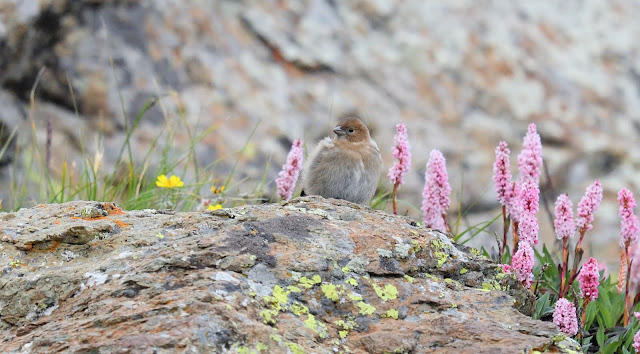This was a day that exceeded all of our expectations as we set out on the drive to Tso Kar and the main purpose of this leg of the tour – to see Tibetan Sandgrouse. Our route took us east along the Indus River valley and then through numerous steep-sided valleys as we climbed ever upwards. Along the way we saw plenty of Chukar, and at one area we encountered the first of many Great Rosefinches we were to see today.
 |
| Chukar |
There was also a group of Red-fronted Serins present, Eurasian Crag-Martin, Blue Rock Thrush and Common Cuckoo before we got slightly further up the road and found Black-winged Snowfinch to be common. As the road zig-zagged up to Tanglangla Pass, Guldenstadt’s Redstart appeared with at least 4 males and 2 females, with one male along the road being particularly cooperative and there was also a superb Robin Accentor.
 |
| Guldenstadt's or White-winged Redstart - stunner! |
What a simply stunning bird! There was also Golden Eagle, Brandt’s Mountain-Finch, and many more Black-winged Snowfinches as well.
 |
| Robin Accentor |
The pass was a whopping 17,582 feet and my altimeter read 5336m and this is apparently the second highest drivable pass in the world. We searched for Tibetan Snowcock here without any success and were 2 days late according to the roadworkers here! But a soaring Saker Falcon was a bit special!
 |
| It's high up here.....! |
 |
| Great scenery on the drive to Tso Kar |
So we dropped down towards Tso Kar and the first birds we saw here were a pair of Ruddy Shelducks and a Hume’s Short-toed Lark, followed by yet more Black-winged Snowfinch, Desert Wheatear etc.
 |
| Our first view of the fantastic scenery at Tso Kar |
Driving into Tso Kar we were extremely fortunate to come across a pair of Tibetan Sandgrouse with 2 chicks right beside the road. They slowly walked away but from the car we had amazing views of this most-prized bird and the reason for coming here in the first place – and we had only been here 10 minutes! We watched as the chicks tried to shelter in the shadow of the parents bodies from the harsh midday sun and totally lapped up this amazing scene. How lucky were we?
 |
| Tibetan Sandgrouse within 10 minutes of arriving.... |
At the Tso Kar Eco-Resort we were pleasantly surprised to see our rooms were en-suite and even more delighted to see a couple of male Great Rosefinches perched on the roof beside some colourful Tibetan prayer flags!
 |
| Great Rosefinch was common |
We had a nice lunch of fried rice before heading out into the plains where we found a family of Ground-Tits, flocks of Twite, many Blanford’s Snowfinch, an Upland Buzzard and what appeared to be a Long-legged Buzzard. A further search for sandgrouse wasn’t successful so we returned to the eco-lodge for an early finish to an extraordinary day.




















































